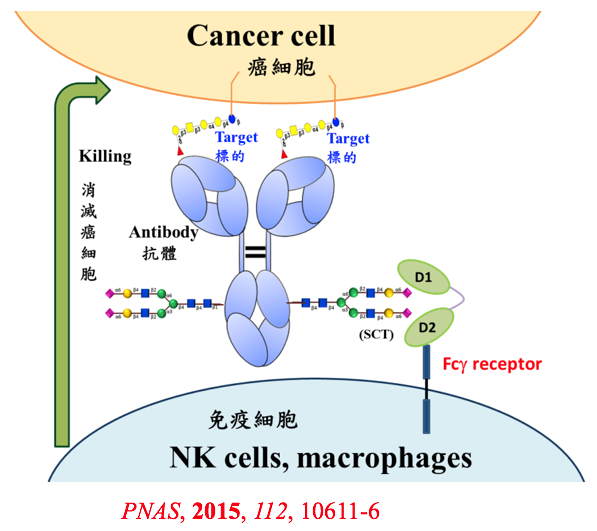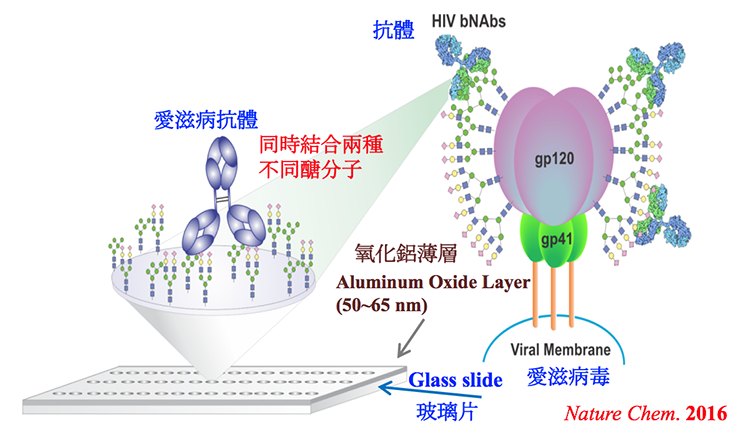The Glycomics focused research team in Genomics Research Center led by President Wong of Academia Sinica has been working on various glycan related subjects and successfully patented their inventions. Some of these technologies have been transferred to a startup company CHO Pharma Inc. for further development. Lately, they have published two academic papers presenting a new method in making better mAbs as well as a more powerful glycan chip that can detect HIV antigens which was impossible previously.
Monoclonal antibodies (mAbs) have been new kids on the block in the antibody-based therapies. The strategy behind mAbs lies in its ability to pinpoint problem causing molecular at its weakness point and disable its activity after aiming it in an extremely focused fashion. While major pharmaceuticals are embracing the development of mAbs without doubt, as an estimated figure of no less than 60% of new drug developments are in this category, it is not a flawless technology in current processes.
Although they claimed to be monoclonal antibodies, due to the current make of these drugs, there tend to have sugar molecules in different structures attached to the bottom of the antibody. For example, the anticancer drug Rituxan alone, has 53 different glycan structures randomly appear at the tail end of it. The existence of these sugar structures has a direct consequence toward the stability and effectiveness of such drugs. Currently available methods use mostly cell lines from mammalian proteins, and how to ensure all the mAbs are made equal has been a top priority for the drug companies.
Wong’s team has a unique track record in making homogenous antibody. With the use of enzyme, the team has successfully modified anti-cancer, anti-influenza, and anti-autoimmune disease antibodies to get rid of the unneeded glycan structures and make such antibodies truly homogenous. Furthermore, by try and error, they have discovered a unique glycan molecule that is acting as a powerful booster for all three types of antibodies. What happens is, when the tail end of these antibodies have nothing else but this unique glycan structure attached to it, the human B cell can work closely with the antibody to perform its duties and thus disable the disease antigen much effectively. The innovative process and the uniquely identified glycan structure has attracted attentions from academic and industry sectors right after they published a paper in PNAS (Proc. Natl. Acad. Sci. U.S.A., 2015, 112, 10611-6).
 Antibody modified with a single Glycan (SCT) is like adding a navigator for the immune cells .
Antibody modified with a single Glycan (SCT) is like adding a navigator for the immune cells .
As they were looking for the better way of making the homogenous mAbs, they needed various glycan structures to conduct the experiments. It is known as a tough mission to synthesize any sugar molecule. Still, they took the challenge and came up with a modular approach. The team identified a basic structure of about 30 different building blocks, and by ways of interlocking, they estimated that they can make around 20,000 various N-glycans out of glycoproteins currently found in human bodies.
 A modular synthesis method facilitates the make of N-glycans.
A modular synthesis method facilitates the make of N-glycans.
These building blocks proved to be an extremely effective weapon not only in the make of better homogenous mAbs, also, in making a better glycan chip.
In the work conducted by a collaborated effort from Scripps research institute, NIH of United States, CHO Pharma Inc. and Wong’s team, they use antibodies derived from HIV patients, by mixing it with various of their glycan module, and distribute on the glycan chips, they actually found a way to identify glycan modules that have a potential to interact with HIV antigens. Prior to this invention, it was very hard to find anti-HIV antibodies with any systematic ways. The work has lately been published in the Nature Chemistry Journal(‘Modular synthesis of N-glycans and arrays for the hetero-ligand binding analysis of HIV antibodies’).
 On the aluminum coated chip, arrays of HIV antibodies teamed with various specific single glycan in each well, clearly identifies glycans with potential in blocking HIV antigens .
On the aluminum coated chip, arrays of HIV antibodies teamed with various specific single glycan in each well, clearly identifies glycans with potential in blocking HIV antigens .
CHO Pharma Inc. is currently in operation in the Academia Sinica Incubation Center, the company obtained more than 30 glycan related technologies from Academia Sinica as its focal platform in drug development and commercialization. Academia Sinica is a major shareholder of this company. The two research papers cited in this release are work led by President Chi-Huey Wong and Associate Research Fellow Chung-Yi Wu from GRC. The funding parties of this work include Academia Sinica, Ministry of Science and Technology, and CHO Pharma Inc.. Related technologies have patents filed and transferred to CHO Pharma Inc. for further commercialization.